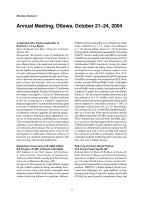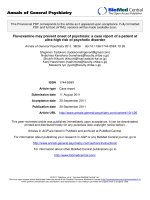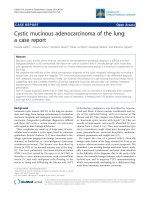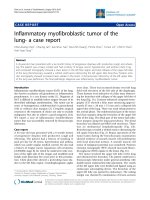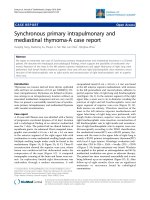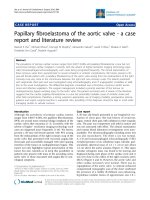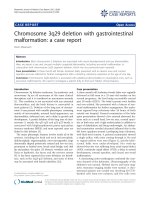Báo cáo y học: " Skin reaction to inhaled tiotropium bromide: a case report." doc
Bạn đang xem bản rút gọn của tài liệu. Xem và tải ngay bản đầy đủ của tài liệu tại đây (246.96 KB, 2 trang )
CAS E RE P O R T Open Access
Skin reaction to inhaled tiotropium bromide:
a case report
Cristoforo Incorvaia
*
, Nicola Fuiano, Raffaella Megali and Gian Galeazzo Riario-Sforza
Abstract
Introduction: Systemic reactions to inhaled drugs are rare. To the best of our knowledge, we report the first case
of generalized itching related to the use of tiotropium bromide, a long acting inhaled anti-cholinergic agent
commonly used to treat chronic obstructive pulmonary disease.
Case present ation: A 78-year-old Caucasian woman was referred to our facility for allergological evaluation. Our
patient had been treated twice with tiotropium for chronic obstructive pulmonary disease and had experienced an
allergic reaction with itching. We performed a double-blind placebo-controlled inhalation challenge for our patient
with tiotropium and a placebo. Inhalation tests yielded positive results for tiotropium and negative results for the
placebo. The results of a skin prick test with tiotropium were negative.
Conclusions: These findings reveal that tiotropium may elicit immediate skin allergic reactions. The negative result
from the skin test suggests that such a reaction is not immunoglobulin E-mediated.
Introduction
Tiotropium bromide is a long-acting inhaled anti-choli-
nergic agent commonly used to treat chronic obstructive
pulmonary disease (COPD) [1]. A recently published
review on drug safety data obtained from 26 clinical
trials involving approximately 17,000 patients reported
that no difference was observed between patients treated
with tiotropium bromid e and those given a placebo,
with respect to the rates of adverse events caused by
cardiac, vascular, nervous, and lower respiratory disor-
ders [2]. Instead, adverse events caused by the anti-
cholinergic effect of tiotropium were much more com-
mon than those due to the placebo. These adverse
effects included dryness in the mouth (observed in
about 16% of the patients treated), constipation, dyspep-
sia, gastroesophageal reflux, dysuria, and urinary reten-
tion. The information provided on skin reactions is
puzzling; in the patient information sheet for tiot ropium
the ‘ Po ssib le side effects’ section reports: ‘Allergic reac-
tions. Symptoms may include: itching, rash, swelling of
the lips, tongue, or throat (trouble swallowing) ’.How-
ever, these reactions have not been mentioned in the
safety data review [2]. In addition, on performing a sys-
tematic literature search of the MEDLINE and EMBASE
databases, we found only one study reporting a tiotro-
pium-associated skin reaction; this study described a
photosensitive lichenoid eruption in a 72-year-old man
[3]. Here, we report a case where a skin reaction to tio-
tropium was obtained in a double-blind placebo-con-
trolled challenge.
Case presentation
Our patient was a 78-year-old Caucasian woman with
COPDforapproximately30yearswhohadonlybeen
treated for it rec ently. In June 2009, our patient was
referred to a pneumologist who prescribed the use of an
18 μg tiotropium inhalation cap sule once daily; this pre-
scription was based on a forced expiratory volume in
one second (FEV
1
) v alue of 59.7% that had been mea-
sured using spirometry. Our patient was not under drug
treatment for any other disease. After three days, she
developed generalized itching with no wheals or edema.
The family physician stopped the tiotropium treatment
and prescribed inhaled salbutamol as needed for dys-
pnea. After five months, our patient was referred to
another pneumologist because of exacerbation of her
COPD sym ptoms; however, she did not inform the
pneumologist of her previous skin reaction to tiotro-
pium. A FEV
1
value of 56.4% was obtained using spiro-
metry, and tiotropium was again prescribed. This time,
* Correspondence:
Department of Allergy/Pulmonary Rehabilitation, ICP Hospital, Milan, Italy
Incorvaia et al. Journal of Medical Case Reports 2011, 5:119
/>JOURNAL OF MEDICAL
CASE REPORTS
© 2011 Incorvaia et al; licensee BioMed Central Ltd. This is an Open Access article distributed under the terms of the Creative
Commons Attribution Lice nse ( which permits unrestricted use, distribution, and
reproduction in any medium, provided the original work is properly cited.
our patient experienced generalized itching approxi-
mately one hour after the first dose. Our patient’s family
physician referred her to us for allergological evaluation.
We performed a double-blind placebo-controlled inhala-
tion challenge with tiotropium, administering the drug
or the placebo on two days consecutively. The lactose
monohydrate excipient contained in the powder was
used as the placebo. Our patient experienced general-
ized itching 50 minutes after inhaling tiotropium but
had no symptoms after inhaling the placebo. As our
patient had experienced an immediate allergic reaction,
we performed a skin prick test (SPT) with tiotropium
diluted in physiological solution; however, the SPT
result was negative. In addition, SPTs performed using a
standard panel of environmental allergens yielded nega-
tive results. We advi sed our patient to avoid using tio-
tropium in the future and prescribed a 9 μg formoterol
inhalation capsule twice a day ; this medication was well
tolerated and effective.
Conclusions
Skin reactions to inhaled drugs used to treat COPD and
asthma are rare and mostly concern corticosteroids [4].
Specifically, no reaction with generalized itching asso-
ciated with the use of tiotropium bromide has been
reported. The repeated reaction with itching in our
patient led us to perform a double-blind, placebo-con-
trolled challenge, w hich revealed that tiotropium may
elicit immediate skin allergic reactions. The negative
result from the skin test suggests that such a reaction is
not mediated by immunoglobulin E.
Consent
Written informed consent was obtained from the patient
for publication of this case report and any accompany-
ing images. A copy o f the written consent is available
for review by the Editor-in-Chief of this journal.
Authors’ contributions
CI analyzed and interpreted the data from our patient regarding the results
of challenge test and skin tests and wrote the manuscript. RM performed
the challenge test. GRS performed the skin tests. NF was a major contributor
in writing the manuscript. All authors read and approved the final
manuscript.
Competing interests
The authors declare that they have no competing interests.
Received: 4 September 2010 Accepted: 28 March 2011
Published: 28 March 2011
References
1. Mamary AJ, Criner GJ: Tiotropium bromide for chronic obstructive
pulmonary disease. Expert Rev Respir Med 2009, 3:211-220.
2. Kesten S, Celli B, Decramer M, Leimer I, Tashkin D: Tiotropium HandiHaler
in the treatment of COPD: a safety review. Int J Chron Obstruct Pulmon
Dis 2009, 4:397-409.
3. Perez-Perez L, Cabanillas M, Pereiro-Ferreiras MM, Peterio C, Toribio J:
Photosensitive lichenoid eruption and inhaled tiotropium bromide.
Dermatology 2007, 214:97-98.
4. Guillot B: Skin reactions to inhaled corticosteroids. Clinical aspects,
incidence, avoidance, and management. Am J Clin Dermatol 2000,
1:107-111.
doi:10.1186/1752-1947-5-119
Cite this article as: Incorvaia et al.: Skin reaction to inhaled tiotropium
bromide: a case report. Journal of Medical Case Reports 2011 5:119.
Submit your next manuscript to BioMed Central
and take full advantage of:
• Convenient online submission
• Thorough peer review
• No space constraints or color figure charges
• Immediate publication on acceptance
• Inclusion in PubMed, CAS, Scopus and Google Scholar
• Research which is freely available for redistribution
Submit your manuscript at
www.biomedcentral.com/submit
Incorvaia et al. Journal of Medical Case Reports 2011, 5:119
/>Page 2 of 2
